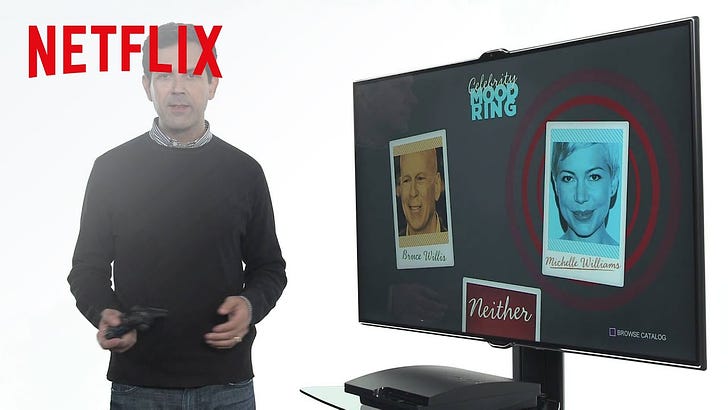Mic Drop #38: Netflix Gaming (2021), Netflix Max (2013-15) & Product Channel Fit
What Q2 2021 Earnings and "Max", a previous Netflix gaming iteration for Playstation tells us about Netflix's mobile gaming plans
I wrote in this week’s Monday AM Briefing that Chief Operating Officer and Chief Product Officer Greg Peters and newly-hired vice president of game development Mike Verdu are going to have newfound influence over content in the Netflix interface.
It is an incremental move with “enormous implications” for how Netflix evolves both in terms of management and in terms of product offering. Peters told investors in the Q2 earnings call on Tuesday:
…we really see [gaming] as an extension of the core entertainment offering that we've been focused on for the last 20 years, right? So just as we've continuously expanded the nature of our offering by adding new genres, unscripted, film, local language programming, animation, on and on, we think we have an opportunity to add gains to that offering and deliver more entertainment value to our members through that. And similar to what you've seen in that trajectory when we've added a new genre, that's what we expect will happen with games. So this is going to be -- it's a multiyear effort. We're going to start relatively small.
We'll learn. We'll grow. We'll refocus our investment based on what we see as working, and we'll just continuously improve based on what our members are telling us is working.
Something about both the move into mobile gaming - and the “We're going to start relatively small” part of the quote - reminded me of Netflix’s “Max” effort on the Playstation between 2013 and 2015.
Here’s an overview video of the service from 2013:
Odds are if you didn’t watch Netflix on a Playstation 3 or Playstation 4 between June 2013 and June 2015, you never tried Max.
Film School Rejects has a good, succinct summary of what using Max was like:
Max’s utter incompetence (especially with his obvious target demographic: indecisive twentysomethings) just added to the allure. He was unveiled with almost zero fanfare (not much more than the video above), and as someone in a social circle with 6,000 Max-less Netflix gadgets and precisely one PS3, Max was an unexplainable enigma. It was like living in the part of Ohio where fast food companies test their bizarre menu prototypes, only instead of the Quesalupa (quesadilla + chalupa), we had a sassy talking version of Netflix.
In short, Max was unapologetically an in-market experiment with gamers.
But, Max is notable here because it was a gaming initiative focused on Product Channel Fit with Playstations, only. Netflix streaming on Playstations had scale in 2013-15.
In 2013, Netflix had over 30MM subscribers in the U.S., and back then 43% of Netflix subscribers in the U.S. used their consoles to stream videos. By 2015, Netflix had ~45MM subscribers in the U.S. alone, but fewer consuming by console.
Playstations were the dominant device in the market (~60%-70% market share) between 2013 and 2015.
So, with 43% of 30MM Netflix subscribers in the U.S. using gaming consoles to stream Netflix, we can assume Netflix market-tested Max with around 8MM subscribers on Playstations in 2013.
By 2015, assuming the percentage of subscribers in the U.S. using gaming consoles to stream Netflix dropped precipitously to something like 20%, or 9MM subscribers. That meant ~6MM subscribers streamed Netflix on Playstations in 2015.
Max was “an extension of the core entertainment offering” that failed, at scale, for Netflix. It didn’t drive growth, it didn’t prevent churn, and Netflix never added it to other platforms.
Why Max Matters
Netflix built Max with Jellyvision, which produced the CD-ROM game You Don’t Know Jack back in 1995.1 So, Max was effectively a streaming version of a CD-ROM game.
In 2017, two years after Max was (mercifully) sunset, Netflix launched two new interface innovations across all platforms:
April 2017: Netflix replaced its five-star rating system with a new “thumbs up/down" feature, which lets you rate titles, and a “percent match” score that predicts the shows and movies you’ll like based on your taste; and,
June 2017: Netflix launched its first two interactive titles, Puss in Book: Trapped in an Epic Tale and Buddy Thunderstruck: The Maybe Pile.
The history lesson is thatMax may not have improved Netflix’s recommendation engine immediately. But, it was a gaming-first offering that contributed to important innovations both within the Netflix interface around recommendations, and around interactive storytelling.
Those innovations helped Netflix to grow by 50% in the U.S., to establish kids and family as 60% of subscribers, and to keep churn low (2.5%) over four years later.
So, coming back to Greg Peters’s quote:
We'll learn. We'll grow. We'll refocus our investment based on what we see as working, and we'll just continuously improve based on what our members are telling us is working.
Mobile gaming seems positioned to help to drive increased mobile adoption and engagement across Netflix’s various markets, especially Asia where it is offering mobile-only deals and where it saw the most growth last quarter (1MM+ net membership additions). Mobile was about 10% of its consumption in 2018. It is likely to be higher now given its rollout of cheaper, mobile-only plans in Asia.
The initiative could fail, like Max did. Greg Peters’ quote seems to be managing expectations for such an outcome.
But it is intended to improve the Netflix user experience for mobile subscribers, especially in a key growth market like Asia with 28MM subscribers.
If you’re wondered where mobile gaming is headed, it’s worth paying attention to its Netflix DNA and listening to Greg Peters more closely.
Member Mailing Update
The Member Mailing was not sent out this week because the essay simply wasn’t working, despite a day’s worth of attempts at editing. It wasn’t working structurally, and it wasn’t working substantively.
The argument was about a fear shared by traditional media CEOs shared at Sun Valley and reported by Variety’s Cynthia Littleton:
Traditional media executives are worried that Apple or Google or Roku or some other third-party player will become the new cable operator — the distribution go-between — by finding a way to bundle rival services to make it easier for subscribers to search for content and pay bills.
I think this an irrational response to how distribution is shaping up, and Product Channel Fit and the PARQOR Hypothesis help to shed light on why this is an irrational fear.
I’m going to take another stab at it next week. Netflix and AT&T earnings helped to add some clarity for the argument.
The former Jellyvision Games is now two companies - the software company Jellyvision and the gaming-focused Jackbox Games.




